Introduction
In the realm of Health, Safety, and Environment (HSE), the risk assessment matrix template serves as a crucial tool for identifying, evaluating, and mitigating risks associated with various operations and activities. This structured approach allows organizations to prioritize risks based on their severity and likelihood, ensuring that resources are allocated effectively to safeguard employees, the environment, and the overall operational integrity.
The significance of a risk assessment matrix template cannot be overstated. It not only aids in compliance with legal and regulatory Standards but also fosters a culture of Safety and awareness within organizations. By utilizing this template, HSE professionals can make informed decisions, enhance Safety protocols, and promote environmental Sustainability.
This article delves into the intricacies of the risk assessment matrix template, exploring its components, benefits, and Best Practices within the HSE context. We will also discuss relevant Regulations and provide actionable insights to help organizations implement effective risk management strategies.
Understanding the Risk Assessment Matrix Template
A risk assessment matrix template is essentially a visual representation that categorizes risks according to their potential impact and the likelihood of occurrence. This matrix typically consists of a grid that plots the severity of risks against their probability. The result is a clear, easy-to-understand overview that helps organizations prioritize which risks need immediate attention and which can be monitored over time.
Components of the Risk Assessment Matrix
To effectively utilize a risk assessment matrix template, it’s essential to understand its key components:
- Likelihood: This is the probability of a risk occurring, often ranked on a scale from low to high. For instance, a likelihood scale can range from 1 (rare) to 5 (almost certain).
- Severity: This component assesses the potential impact of the risk, which can range from minor injury or inconvenience to catastrophic failure or loss of life. A severity scale can also range from 1 (negligible) to 5 (catastrophic).
- Risk Rating: By combining the likelihood and severity, a risk rating (usually represented as a number or color code) can be established. This helps in visualizing the overall risk level.
- Action Plan: This outlines the steps that will be taken to mitigate each identified risk. It includes assigning responsibilities, timelines, and resources needed for implementation.
Benefits of Using a Risk Assessment Matrix Template
1. **Clarity and Focus:** The matrix provides a straightforward visualization of risks, allowing stakeholders to quickly grasp the most pressing issues that require attention.
2. **Prioritization:** By categorizing risks, organizations can focus their resources on the most critical areas, ensuring that Safety Measures are effective and responsive.
3. **Communication Tool:** The matrix can serve as an effective communication tool among team members and stakeholders, promoting a shared understanding of risks and safety priorities.
4. **Regulatory Compliance:** Utilizing a risk assessment matrix can help organizations meet legal and regulatory requirements, thereby reducing the likelihood of penalties or sanctions.
5. **Continuous Improvement:** Regularly updating the matrix encourages a culture of continuous improvement, as organizations must regularly reassess risks and their mitigation strategies.
Implementing a Risk Assessment Matrix Template
Creating an effective risk assessment matrix template involves several steps:
1. **Identify Risks:** Conduct thorough brainstorming sessions, surveys, or focus groups to identify potential Hazards in the workplace or operational processes.
2. **Evaluate Risks:** Assess the likelihood and severity of each identified risk. Engage subject matter experts to ensure accurate evaluations.
3. **Develop the Matrix:** Use a grid format to create the risk assessment matrix. Label the axes for likelihood and severity, and plot the identified risks accordingly.
4. **Assign Risk Ratings:** Based on the established scales, assign risk ratings to each identified risk. This could involve color coding for easy visualization (e.g., green for low risk, yellow for moderate risk, red for high risk).
5. **Create Action Plans:** For each high-risk item, develop an actionable plan detailing the steps needed to mitigate the risk, assign responsibilities, and set timelines for completion.
6. **Review and Update Regularly:** Risk assessment is not a one-time activity. Regularly review and update the matrix to reflect any changes in operations, regulations, or emerging risks.
Real-Life Applications of Risk Assessment Matrix Template
To understand the practical application of a risk assessment matrix template, consider a hypothetical construction company. The organization undertakes various projects in different locations and faces numerous risks, including falls from heights, equipment failures, and hazardous material exposure.
By employing a risk assessment matrix template, the company identifies that falls from heights are not only highly likely but also severe, given the potential for serious injuries or fatalities. This risk is plotted in the high-risk category of the matrix.
In response, the company develops an action plan that includes the following:
- Mandatory safety Training for all employees working at heights.
- Regular inspections of safety equipment, such as harnesses and scaffolding.
- Implementation of a buddy system to ensure no worker is alone while working at heights.
By addressing this high-risk area, the company significantly reduces the incidence of falls, promoting a safer work environment and demonstrating its commitment to HSE practices.
Regulations and Standards Impacting Risk Assessment Matrix Template
Understanding the legal framework surrounding HSE is vital for effective risk management. Several key regulations and standards influence the use of risk assessment matrices:
1. **Occupational Safety and Health Administration (OSHA):** osha mandates employers to provide a safe workplace, which includes conducting risk assessments and implementing safety protocols. Failure to comply can result in severe penalties.
2. **ISO 45001:** This international standard outlines requirements for an Occupational Health and safety management system. It emphasizes the need for risk assessments and continuous improvement, making the risk assessment matrix template an essential tool in achieving compliance.
3. **Environmental Protection Agency (EPA):** The EPA sets forth regulations to protect the environment. Organizations must assess risks related to environmental impacts, and a risk assessment matrix can facilitate compliance with these standards.
By integrating the risk assessment matrix template into their health, safety, and environmental management practices, organizations can ensure alignment with these regulations while enhancing their overall safety and environmental performance.
Best Practices for Using a Risk Assessment Matrix Template
To maximize the effectiveness of a risk assessment matrix template, consider the following Best Practices:
1. **Involve Stakeholders:** Engage employees at all levels in the risk assessment process. Their insights can provide valuable information about potential risks and contribute to a culture of safety.
2. **Be Specific:** Clearly define the criteria for likelihood and severity. This specificity helps in aligning assessments across different teams and projects.
3. **Utilize Technology:** Consider using software solutions that can streamline the creation and updating of risk assessment matrices. This can enhance collaboration and ensure that all team members have access to the most current information.
4. **Document Everything:** Keep thorough records of risk assessments, action plans, and follow-up actions. This documentation can be crucial in demonstrating compliance during audits.
5. **Train Regularly:** Provide ongoing training for employees on risk assessment processes and the importance of the matrix. Regular training sessions reinforce the value of risk management as a shared responsibility.
Conclusion
The risk assessment matrix template is an indispensable tool in the Health, Safety, and Environment landscape. By systematically identifying, evaluating, and mitigating risks, organizations can promote a culture of safety and compliance while ensuring the well-being of their employees and the environment.
As workplace dynamics and regulatory landscapes continue to evolve, the importance of effective risk management cannot be overstated. Organizations that prioritize the use of a risk assessment matrix template will not only meet their legal obligations but also foster a proactive approach to safety and sustainability.
In conclusion, make the effort to implement and regularly update your risk assessment matrix template. It is not just a compliance requirement; it is a commitment to a safer, healthier, and more environmentally responsible way of operating.


